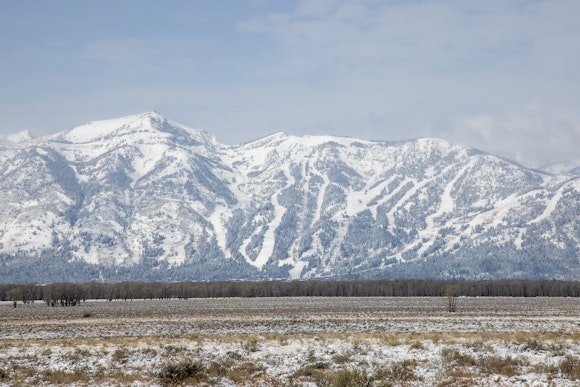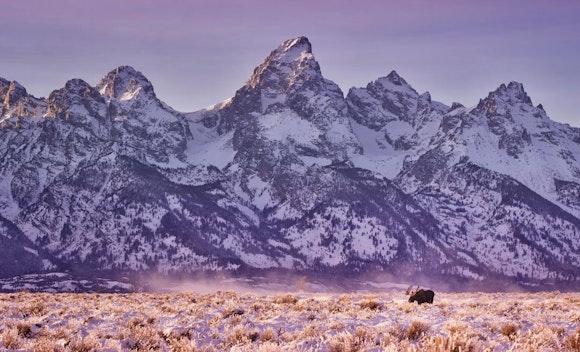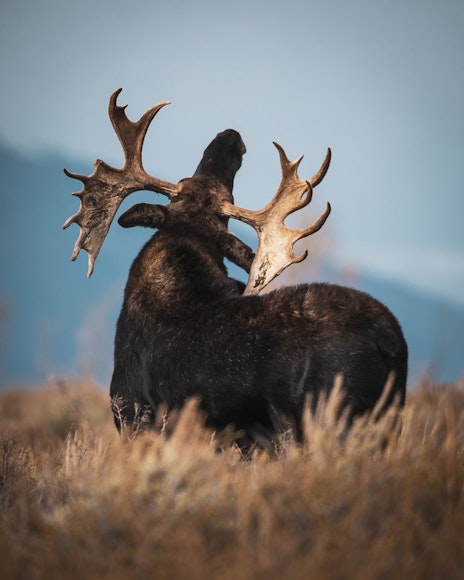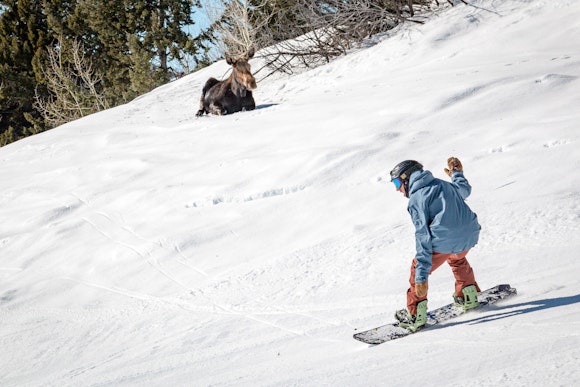As we celebrate Mother Earth on this special day, let’s remember to respect our natural surroundings and the wildlife that inhabit our beautiful surroundings.
When it comes to wildlife, social distancing must always be practiced.
“As stewards of the land and environment, we have to protect the wildlife that inhabits our mountain and we kindly ask our guests to do the same as their survival depends on all of us, “says Connie Kemmerer, part owner of Jackson Hole Mountain Resort.
Every couple of years, video footage of a skier or snowboarder at Jackson Hole Mountain Resort being chased by a moose goes viral. The audio usually includes screams, laughter and slight panic. But, try for a moment to put yourself in the hooves of the moose rather than the boots of the snowboarder. Imagine you are scared, threatened, hungry and tired. You’re wandering prime habitat when a human comes flying downhill at high speed out of nowhere. You’ve lost 20 percent of your body mass during the winter months, you’ve spent the last hour foraging through deep snow for twigs and branches, and you’re cranky. You need an hour to rest and digest—moving too quickly could burn through your precious winter reserves. Being startled by a skier doesn’t just feel life threatening—it’s actually putting you at risk of not surviving the harshest season.

JHMR sits on a 3.4 million-acre swath of public land that’s part of a 22-million-acre uninterrupted ecosystem
When you ski and snowboard at Jackson Hole Mountain Resort, you are recreating in the Bridger-Teton National Forest, a 3.4 million-acre swath of public land that’s part of a 22-million-acre uninterrupted ecosystem.
“When you’re skiing at Jackson Hole Mountain Resort, you’re in an incredible place,” says Mary Cernicek, Public Affairs Officer for Bridger-Teton National Forest Service. “You’re part of the Greater Yellowstone Ecosystem—the largest intact ecosystem in the Lower 48. If you stand still for a moment, it will empower you. We are visitors, and we need to be respectful.”

“We are visitors, and we need to be respectful.”
The Bridger-Teton National Forest is known for its abundant and diverse wildlife, including grizzly bear, moose, bighorn sheep, elk, mule deer (60 other species of mammals) and more than 355 species of birds. To conserve energy in winter, animals often use groomed and packed surfaces where travel is easier. “When the snow gets deep—as it often does here—it gets hard for moose,” says JHMR ski patrol director Drew Kneeland. “They use the ski runs to get around because it’s less tiring and less stressful. This puts them close to skiers.”
With both recreation activity and wildlife confined to more limited terrain in the winter, extra effort is needed to protect wildlife and yourself. Disturbing wildlife in winter forces animals to expend precious energy. “They need to hold on to those reserves,” says Cernicek. “If you get to close or panic them, they use those reserves, which makes them more susceptible to disease and predators.” It also might send them to another territory to forage for food that might not be as convenient.

Moose are a big part of the greater Jackson ecosystem.
About 800 moose inhabit Grand Teton National Park, the southern part of Yellowstone, and the Bridger-Teton National Forest, which includes JHMR. Moose, the largest member of the deer family, can weigh up to 1,400 pounds, and they are dangerous to approach. Moose can be particularly aggressive in winter when food is scarce and females are often pregnant. And keep in mind moose can run up to 35 mph.
Kneeland says moose have been a part of skiing in Jackson since he started patrolling in 1994. He even had an interaction with a moose this February while skiing off the Moose Creek chairlift with his wife and young children. As Kneeland and his wife were shuffling their young children through deep snow, a moose approached them and came as close as 25 feet. Kneeland and his wife started banging their poles together to scare off the moose, and he instructed his four and seven year old to follow suit. The moose eventually turned around and ran down the groomed run. Another moose spent a large part of the season in Sundance Gully, directly underneath the Bridger Gondola. And ski patrol has even had to usher moose out of the base area. But Kneeland says it’s far easier to educate skiers and snowboarders on how to avoid moose.

Moose stay hidden within the JHMR boundary. Stay vigilant and never approach them!
“We each have a personal responsibility to not stress these animals out,” he says. By keeping wildlife’s best interest in mind, both visiting and local skiers and snowboarders can strengthen bonds to wildlife conservation through preparation, education and awareness. After all, we’re all playing in their backyard.”
Follow these best practices to protect the wildlife that help make this part of the world so special.
– Avoid surprise encounters. Be alert, look and listen for wildlife. Moose often bed down below your line of sight.
– Give moose, and all wildlife, space—at least 25 yards.
-Be prepared to turn around or travel off trail if you encounter wildlife.
-Avoid photographing animals. If you must, do so from a distance and without disturbing them.
-Remember, a fed animal is a dead animal. Wild animals should never be fed human food; it is bad for their health. Animals dependent upon handouts can lose their ability to find their own natural food.
-If you encounter a moose or other large animals on the trail, stop, back away slowly and change your course.